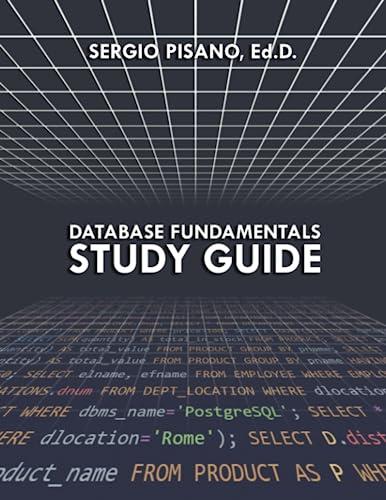Question
In this exercise you will be given an m n matrix A. Your program has to create two bases (both are named B): one -
In this exercise you will be given an m n matrix A. Your program has to create two bases (both are named B): one - for Col A and one - for m if Col A m , by using the columns of the given matrix A.
Your program should allow a possibility that the columns of A are not linearly independent, that is, not all columns of A will be in a basis. The set of columns of A can be shrunk to a basis for Col A by using the function shrink. Here is the code:
function B = shrink(A) [~, pivot] = rref(A); B = A(: , pivot);
**Create the function B = shrink(A) in MATLAB. **Type the function shrink in your diary file **Run each of the commands listed below (separately) on the matrix A=magic(4) [~, pivot] = rref(A) B = A(: , pivot)
% Place a comment in your diary file on the output for each of the commands.
**Create the function in MATLAB function B=basis(A)
The function should start with the commands: m=size(A,1); A=shrink(A); sprintf(a basis for Col A is \ n) B=A
This part will give you as an answer a basis B for Col A. Then, you will be using a conditional MATLAB statement within your code to check whether the matrix B, that you found, is a basis for m (or, the same, whether Col A = m ). If yes, the program breaks with the message: sprintf(a basis for R^% i is \ n, m) (it will return your B) If B is not a basis for R^m , you should expand B to a basis for R^m . Use the matrices B and eye(m) and the command shrink to create a new matrix D, which will be a basis for R^m . (A basis has to contain all vectors from B and some vectors from the matrix eye(m)). You should also write a set of commands within your code to verify whether the new matrix D is, indeed, a basis for R^m - the command rank will be helpful. If your code confirms that D is a basis for R^m , the output message should be: sprintf(a basis for R^% i is \ n, m) B=D;
otherwise, the program breaks with a message similar to that: disp (What? It is not a basis!?) **Type the function basis within the diary file. **Run the function B=basis(A) for the following matrices:
(a) A = [1, 0; 0, 0; 0, 0; 0,1] , (b) A = [2, 0; 4, 0; 1, 0; 0,0] , (c) A = magic(3) , (d) A = magic(6)
Step by Step Solution
There are 3 Steps involved in it
Step: 1

Get Instant Access to Expert-Tailored Solutions
See step-by-step solutions with expert insights and AI powered tools for academic success
Step: 2

Step: 3

Ace Your Homework with AI
Get the answers you need in no time with our AI-driven, step-by-step assistance
Get Started


